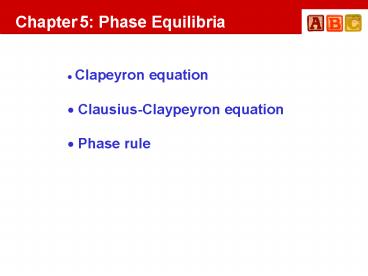Animated ABC Blocks PowerPoint PPT Presentation
1 / 17
Title: Animated ABC Blocks
1
Chapter 5 Phase Equilibria
- Clapeyron equation
- Clausius-Claypeyron equation
- Phase rule
2
? Clayperon equation
at equilibrium ?G 0
3
From
(At equilibrium)
Slope of the plot between P and T
4
?S/ ?V
?Vm
?Sm
gt 0 gt 0 gt 0
gt 0 gt 0 gt 0
gt 0 gt 0 gt 0
?S/ ?V lt 0
In case of H2O Vm,s gt Vm,l ?Vm lt 0
hence
5
H2O
6
From ?S At phase transition ?S tr We
obtain Clapeyron equation
7
Example 5.1 What is the boiling temperature for
water at 2000 meter high above the sea level.
Given p p0e-gMh/RT, the barometric formular,
where g 9.81 ms-2 , M molar mass, hheight, and
T298 K and the heat of vaporization of water is
40.7 kJ/mol
?P p - p0 p0 (e-gMh/RT -1) gMh/RT
(9.81ms-2)(18x10-3 kg/mol)(2000 m)
(8.314 J/molK)(298K) 0.0152 ? ?P
(1 atm)(e-0.0152 -1) -0.0151 atm
-1528 Pa
8
?V Vg Vl Vg nRT/P
(1mol)(0.082 L atm/K mol)(373K)/0.9849 atm
31.05 L/mol 31.05 x 10-3 m3/mol From Clapeyron
equation
9
Clausius Clapeyron
From Clapeyron equation
If the phase transition is from l to g
then ?Htr ?Hvap
?V Vm,g - Vm,l Vm,g Using ideal
gas equation ?V RT/P
10
Substitute in Clapeyron equation,
Clausius Clapeyron equation
11
Example 4.2 The boiling point of benzene is
80.1C at 1 atm. Estimate the vapor pressure of
benzene at 25C
From
Here P1 1 atm and T1 80.1C
353.3 K
P2 ? and T2 25C
298 K
12
Using Troutons rule
?Svap ?Hvap/Tb 88 J/Kmol
?Hvap Tb ?Svap (353.3 K)( 88
J/Kmol) ln(P2/1atm) (353.3 K)( 88
J/Kmol)(-55.1K) (8.314 J/Kmol) (353.3 K)(298
K) -1.597 P2
(1atm)e-1.597 0.141 atm
13
Phase rule
- Number of free variables needed to describe the
system is called degree of freedom (F) - For single component and single phase system,
only 2 variables, P and T, are required and it
has 2 degree of freedom (F 2) - A(T,P)
- For C components, we only need C 1 variables.
- Since x1 x2 ..xc 1
- For C components and single phase,
- F (C-1) 2
- A(T, P, x1, x2 ,.,xc-1)
- For C components and P phases, there must be
- P(C-1) variables
14
- There establishes equilibrium between phases,
C components
For P phases
C equations
.
For 1 component and 2 phases µa µß ?P
(?S/?V) ?T Number of free variables is 1 2
(P-1) Number of free variables is reduced by
(P-1)
15
For C components and P phases, there are C
equations For each components, number of free
variables is reduced by (P-1) Overall
reduction of variables is C(P-1)
F P(C-1) 2 - C(P-1)
PC - P 2 - PC C
F C - P 2
phase rule
16
phase Component F 1 1 2 T, P
2 1 1 3 1 0 1 2 3 T, P,
x 2 2 2
17
(No Transcript)

